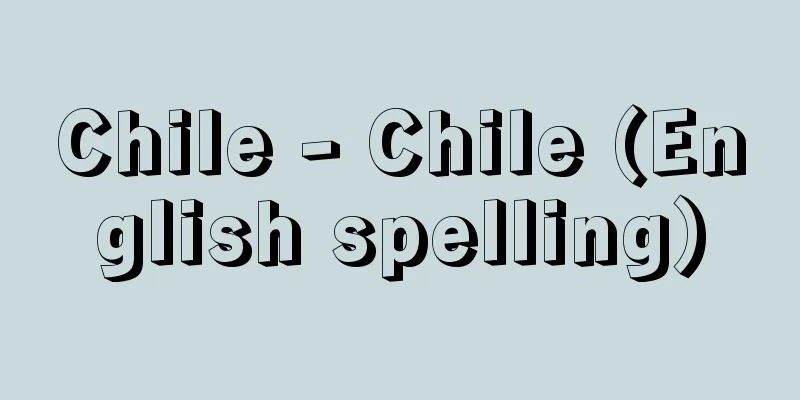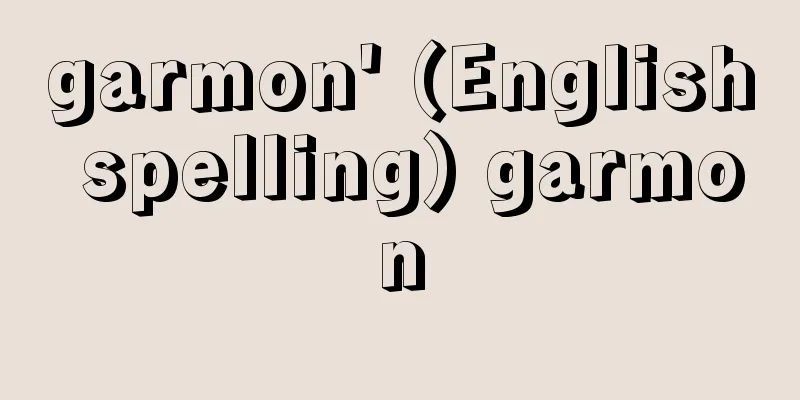Chile - Chile (English spelling)

|
A republic located on the southwest coast of South America. Its official name is República de Chile. There is no consensus on the origin of the country's name, but the most widely accepted theory is that it comes from an Aymara word meaning "where the earth ends." The country is long and narrow, stretching from the border with Peru at 17°30' south latitude in the north to Cape Horn at 55°59' south latitude in the south, along the Andes Mountains. Its length is 4,270 km, but its width from east to west is only 355 km at its widest point and 175 km on average. It faces the Pacific Ocean to the west and shares borders with Bolivia and Argentina to the east. Its total land area is 756,102 square kilometers, about twice that of Japan. It also claims sovereignty over the part of Antarctica between 53° and 90° west longitude, and has a military observation base there. Chile also owns Easter Island, 3,750 km from the mainland in the South Pacific Ocean, as well as the Juan Fernandez Islands. In 1984, Chile and Argentina concluded that the three small islands in the Beagle Channel at the southern tip of the country, which had been in dispute, belonged to Chile. Population: 15,116,435 (2002 census). [Akio Hosono] NatureTopographically, it consists of the Andes Mountains on the east side, which run north to south, the coastal mountain range on the Pacific side, and the central plain between the two mountain ranges. The central plain is a plateau-like desert in the north, and an alluvial fan and sedimentary plain filled with sediment from the two mountain ranges in the central part. Furthermore, large and small lakes are scattered south of Temuco. South of Puerto Montt, the part of the extension of the plain sinks into the sea and both sides become fjord-like coasts, and the part of the extension of the coastal mountain range forms an archipelago starting from Chiloe Island and connecting to the Beagle Islands at Cape Horn at the southern end. The Andes Mountains are a Tertiary folded mountain range. There are many high mountains in the north and central parts of Chile, including Mount Aconcagua (6,960 meters, but the summit is in Argentina), the highest peak in the Americas, and Mount Ojos del Salado (6,880 meters, the highest peak in Chile). There are many volcanoes on the Chilean side of the Andes, including the Osorno Volcano (2,660 meters) in the south, which resembles Mount Fuji, and there are 55 active volcanoes in total. Therefore, Chile is one of the world's most earthquake-prone regions, and a major earthquake that struck the south in 1960 killed many people and sent a tsunami across the Pacific Ocean that reached as far away as Japan. Chile is long and narrow from north to south, and its climate can be roughly divided into three regions, from the desert in the north to the glacial zone in the south. The northern part, from the border with Peru to the city of Coquimbo (latitude 30 degrees south), is an arid region, mostly consisting of the vast Atacama and Tarapaca deserts. This region is not only located in the mid-latitude high pressure zone, but is also washed by the Humboldt Current (Peruvian Current) along the Pacific coast, making it the driest region in the world, as can be seen by the annual precipitation of 0.7 mm in Arica. The central part, up to the Bio Bio River (latitude 37 degrees south), is in the temperate zone, and has a Mediterranean climate with dry summers and relatively rainy winters (annual precipitation of 362 mm in Santiago), making it the most comfortable climate zone in Chile and the most important agricultural area. The southern part is south of the city of Concepción, and the amount of precipitation increases the further south (2035 mm in Chiloé Island and Ancudó), and further south the area receives 2000-5000 mm of rainfall, making it one of the world's largest forest areas, made up of evergreen broadleaf and coniferous trees. In the southern part, up to the area around Puerto Montt, grain farming and livestock farming are thriving, but the area south of there, Patagonia, is known for its heavy snowfall, with mountain glaciers from the Andes stretching all the way to the coast. In addition, from the Strait of Magellan at the southernmost tip to Tierra del Fuego, precipitation is low (442 mm in Punta Arenas), but strong winds blow. [Akio Hosono] GeographyEconomic activity is strongly influenced by the climatic conditions of each region. In the north, agriculture is only practiced in a few coastal areas where irrigation is possible, and mining and fishing are the main economic activities. The area from Iquique to Antofagasta was once an area where saltpeter mining was active, and Iquique was a saltpeter shipping port. Although a small amount of production continues today, many saltpeter towns have become ghost towns and are left behind in the desert. In the north, copper production has replaced saltpeter, and there are mines such as Chuquicamata, the world's largest open-cut copper mine, and El Salvador, and the copper refining industry is also well developed. Iron ore is also exported. Furthermore, fishing has become popular in recent years, and Iquique has become a shipping port for fish meal. Antofagasta, located to the south, is the largest city in the north, and is an export port for copper and other products, as well as the commercial and cultural center of the north. Arica, which borders Peru, has a railway line that connects it to La Paz, the capital of Bolivia, and is also a transit point for cargo to Bolivia. The central part of Chile is the richest agricultural region in the country, producing grapes and other fruits and grains, but it is also the center of mining and manufacturing, with many cities, including the capital, Santiago, where about 30% of the total population is concentrated. There is the port of Valparaiso, Santiago's outer port and Chile's largest port, the adjacent coastal resort city of Viña del Mar, the base of the El Teniente mine, Chile's second largest copper mine, and the port of San Antonio, the copper shipping port, the agricultural centers of Talca and Chillán, and to the south, the city of Concepción, one of Chile's leading industrial cities, and the adjacent outer port of Talcahuano. South of Concepcion, the amount of rainfall is high, so grain farming, livestock farming, and forestry are thriving, and there are beautiful lakes and marshes, including Temuco, Valdivia, Osorno, Puerto Montt, etc. Sheep farming is thriving in the area from the Strait of Magellan to Tierra del Fuego, and the world's southernmost city, Punta Arenas, is located there. [Akio Hosono] historyColonial periodDiego de Almagro, a friend of the Peruvian conqueror Pizarro, invaded Chile in 1536, but returned to Peru after failing to find the gold he was looking for. Then, in 1540, Pedro de Valdivia, a subordinate of Pizarro, invaded Chile, and founded Santiago the following year. He gradually advanced southward, but encountered strong resistance from the indigenous Araucan people. As a result, he was unable to manage the colony by plundering and mining precious metals as in Mexico and Peru, and only small-scale agriculture and livestock farming were carried out at first. From 1557 to the end of the 18th century, Chile was governed by governors who reported directly to the viceroy of Peru. The first governor, Garcia Hurtado de Mendoza, fought fiercely against the Araucans, killing their chief, Caupolicán, and the occupation of the area north of the Bio Bio River by the Spanish was confirmed. As a result, agriculture flourished in the central region, and gold mining also began, and especially in the 18th century, mining of gold, silver, and copper became active. However, British and Dutch pirates appeared on the Chilean coast, and wars with the indigenous peoples, such as the Araucanians, continued until the first half of the 19th century (although there were periods of peaceful coexistence through peace negotiations), forcing Spain to spend a large amount of money on military expenditures to defend Chile. Furthermore, smuggling was actively carried out in response to Spain's trade monopoly. The Bourbon dynasty was established in Spain in the 18th century, but since 1765, King Carlos III abolished the trade monopoly of chartered ports and chartered merchants, and trade with the home country was liberalized at the ports of Valparaiso and Talcahuano in Chile from 1778. The king also made Chile an independent viceroy in 1778, free from the rule of the governor-general who was directly subordinate to the Viceroy of Lima. [Akio Hosono] Independence and the 19th centuryHowever, influenced by the American independence and the French Revolution, Chilean criollos (local-born Spaniards) became increasingly dissatisfied with colonial rule, and the movement for independence intensified after Napoleon's invasion of Spain (1808). On September 18, 1810, the Santiago City Council established an autonomous government, declared freedom of trade, and convened a national assembly (this day is still celebrated as Chile's Independence Day). In response, the viceroy of Peru, under orders from his home government, sent troops to Chile. The Chilean army fought fiercely under the command of José Miguel Carrera and Bernardo O'Higgins (son of the former viceroy of Peru), but was defeated in the Battle of Rancagua in 1814. However, O'Higgins, who had fled to Argentina, counterattacked across the Andes Mountains in 1817 with Argentinean José de San Martín, defeated the Spanish army in the Battle of Chacabuco, and declared independence the following February 1818. For this reason, O'Higgins is called the father of Chilean independence. Furthermore, in April of the same year, the Spanish army was completely defeated in the Battle of Maipu. The period of turmoil following independence was short compared to other Latin American countries, and in 1833, then-Vice President Diego Portales put an end to the civil war, promulgated a new constitution, and established constitutional government. This political stability also led to economic development. In the early 19th century, the main export was gold, but in 1831, reverberatory furnaces were introduced to process copper sulfide ores, and copper production steadily increased, reaching 10,000 tons in the 1840s, making Chile the second largest producer after the United Kingdom, and the largest in the world in the 1850s. Saltpeter production, which began around this time, expanded rapidly in the 1860s when saltpeter was used to manufacture explosives. Copper exports declined in the mid-1870s, but in 1879, a war broke out between Chile and Bolivia and Peru over the possession of saltpeter-producing areas (known as the "War of the Pacific"), with Chile emerging as the victor in 1883. As a result, Chile came to possess the Bolivian provinces of Antofagasta and Tarapacá, as well as the Peruvian provinces of Tacna and Arica (Tacna was later returned). These areas were rich in mineral resources, not only saltpeter but also copper and other minerals, and their annexation brought great prosperity to the Chilean economy. However, since the saltpeter industry was controlled by British capital at the time, José Manuel Balmaceda, who became president in 1886, tried to implement a policy of economic independence by nationalizing the mines, but was forced to resign due to resistance from the ruling class who shared interests with British capital. Meanwhile, agricultural areas in the central and southern parts of the country expanded production to supply food to the mining regions of the country, as well as to increase exports to California (mid-19th century), Peru, and the United Kingdom, where food demand had increased sharply during the Gold Rush. Even after independence, conflicts with the Araucanos continued south of the Bio Bio River, so agriculture developed mainly in the central part of the country until the mid-19th century. In this region, agriculture centered on large farms called fundos developed from around the 17th century. Labor was provided by inquilinos, who were given a house and a small piece of farmland for self-sufficiency, but were obliged to work for the fundos. This system was called inquilinaje. As the demand for agricultural products increased sharply from the 1840s, the fundos gradually took on the characteristics of corporate large farms, and with the abolition of the primogeniture system in 1852, the fundos began to be divided and traded from the 1860s, and land was concentrated in a few fundos. Furthermore, in the second half of the 19th century, the Chilean army's dominance over the Araucanos in the south became decisive, and in 1883 they were confined to a limited reservation, which allowed the use of vast tracts of unused land south of the Bio Bio River for agriculture. From the middle of the 19th century, farmers began settling in this region in earnest, and large plantations were formed. Furthermore, from 1872, the government took measures to promote European immigration, and the number of German, French, Spanish and other immigrants to Valdivia, Osorno and other areas increased, settling down as self-employed farmers and engaging in wheat production and livestock farming. [Akio Hosono] Early 20th centuryWith the development of mining and agriculture, a middle class was formed relatively early, and in the industrial areas of the north, worker organization began to progress from the end of the 19th century. The labor movement expanded further in the early 20th century, with a large-scale strike by saltpeter workers in Iquique in 1907, but the government severely suppressed it. In this environment, Arturo Alessandri Palma emerged, advocating social justice and reform. He appealed to the dissatisfaction of the middle and working classes due to the inflation during World War I and the recession after the war, and became president in 1920. However, the reforms he proposed were blocked by conservatives, and social unrest instead increased. In response to this situation, the military intervened in politics in 1924 and passed the Three Labor Laws. The following year, a group of young officers led by Carlos Ibáñez del Campo advocated the implementation of social reform, and restored Alessandri to the presidency. The 1925 Constitution, which was established in this way, was based on the separation of church and state and the strengthening of the power of the president, and broke the conservative political system that had existed until then. Meanwhile, copper production gradually decreased toward the end of the 19th century, while saltpeter production increased, so that saltpeter accounted for 80% of Chile's mining production in the early 20th century. However, as the demand for copper increased worldwide, the development of large copper mines began in the early 20th century by introducing the mass processing technology for low-grade ore that had been advanced since the end of the 19th century. This was evident in the establishment of companies to develop the El Teniente copper mine in 1904 and the Chuquicamata copper mine in 1912. These copper mines were developed by American multinational copper producing companies (Anaconda Co. and Kennecott Co.), and production increased rapidly, exceeding 200,000 tons per year in the 1920s. In contrast, saltpeter gradually lost its overseas market due to the development of artificial fertilizers after World War I, and copper replaced saltpeter as the main export item. As a commodity exporting country, Chile was hit hard by the Great Depression of 1929, and the conservative Ibáñez government that had been in power since 1927 collapsed in 1931, leading to continued political turmoil. A socialist republic was established for a short period in 1932. However, at the end of the same year, a second Alessandri government was formed with the support of centrist forces, mainly the Radical Party, and political stability was restored. This government promoted industrialization under a protectionist trade policy, and an important shift was made from the previous commodity export economy to an import-substitution industrialized economy for the domestic market. Anti-Alessandri forces came together, leading to the formation of the Popular Front in 1936, and the formation of the Pedro Aguirre Cerda government in 1938, which promoted import-substitution industrialization even more vigorously. [Akio Hosono] After World War IIRadical political forces continued to dominate the country from World War II through the postwar period, but the economy stalled in the late 1950s due to inflation and a deficit in the balance of payments. Conservative Jorge Alessandri was elected in the 1958 presidential election and made efforts to stabilize and restore the economy through economic liberalization and fiscal balance, but he was unable to achieve results in economic recovery due to the extensive damage caused by the 1960 southern Chile earthquake. With conservative forces in decline, Eduardo Frei of the center-left Christian Democratic Party became president in 1964, defeating his strong rival Salvador Allende, who was supported by the Socialist Party and the Communist Party. Frei adopted the slogan "Revolution under Liberty" and promoted land reform, the "Chileanization" of the copper industry, further promotion of industrialization, and education reform, achieving remarkable results. However, the expansion of government spending and rising inflation led to growing dissatisfaction among the working class and the poor, despite the reforms. With the support of these groups, Allende of the Popular Alliance, which was made up of the Communist Party, the Socialist Party, the Radical Party and other parties, came in first in the presidential election in September 1970, and with his approval by the National Assembly in November, the first socialist government founded through democratic procedures in Latin America was born. The Allende administration promoted socialist policies such as the nationalization of large American copper mines, the thorough implementation of the agrarian reform that had been underway under the Frey administration, and the nationalization of private banks. Initially, economic policies progressed relatively smoothly, with domestic business expanding by raising real wages and industrial production expanding by utilizing idle facilities, but from mid-1972, inflation, shortages of goods, the expansion of the black market, and other problems began to appear, and the economic situation worsened. Amid the confusion and worsening economic situation that accompanied the reforms, the middle class, including self-employed people such as truck drivers, turned away from the Allende administration, and strikes and anti-government demonstrations became frequent after October 1972. The US government also opposed the free nationalization of copper companies, and economic aid was suspended. In order to weather the political turmoil and the economic crisis in which foreign currency reserves had run out and inflation was soaring, the Allende administration brought the military into the government, including appointing Army Commander-in-Chief General Carlos Pratz as Minister of the Interior, but the situation did not improve, and General Pratz resigned in August 1973. At that time, Congress passed a resolution criticizing the government for "serious violations of the constitutional and legal order of the Republic." On September 11, 1973, a coup was carried out by the army, navy, air force and police, and a military council was established with Army Commander Augusto Pinochet as its head. President Allende resisted the coup by staying in the presidential palace (he died), and there was strong resistance from labor unions and other groups, but the military responded with severe repression. The Pinochet administration, from an anti-Marxist perspective, advocated "restoring order and institutions" and banned all political party activity, including the Conservative Party. In terms of the economy, it implemented a free economic policy that was fundamentally different from both the Frei and Allende administrations. It aimed to develop the economy through free market mechanisms, such as lowering external tariffs to a uniform 10%, abolishing price controls and liberalizing the domestic financial market. It also returned some farmland to landowners and privatized companies in which the state had intervened. However, the policy of managing the nationalized copper mines by state-run companies was basically unchanged. However, due to amendments to the Foreign Investment Law, the development of new copper mines has been opened up to foreign companies. The constitution had been suspended after the 1973 coup, but a new constitution was approved by referendum in September 1980 and came into force in 1981. This constitution provided for provisional provisions until 1989, and a Military Council made up of representatives from the three armed forces and the police exercised legislative power. Meanwhile, under the free economic policies of the Pinochet administration, Chile's economy was successful in controlling inflation and expanding non-traditional exports that were not dependent on copper exports, and the growth rate rose temporarily, but as a result of large amounts of foreign loans, the country fell into a serious debt crisis in 1982. Chile's major banks were placed under de facto state control, and many companies fell into financial difficulties, resulting in economic growth of minus 14.3% that year and minus 0.8% in 1983, which continued to be sluggish, and the unemployment rate reached a high level of nearly 20%. This worsening economic situation and public dissatisfaction with the prolonged military regime gradually grew, and in May 1983, a nationwide protest movement was launched at the call of the chairman of the Seguer copper mine workers' union, and at a protest rally in August of the same year, many people were killed in clashes with security authorities. After this, the government tried to adopt a dialogue approach, but was unsuccessful, and various political parties and labor unions repeatedly protested, demanding an early transfer of power to civilian rule and improvements to economic policies. The Catholic Church also criticized the Pinochet regime from a position of protecting the people and called for national reconciliation. Under these circumstances, a vote of confidence was held in October 1988 on whether President Pinochet would become the next president in accordance with the Constitution, but 54% of voters opposed him, exceeding his 43% support. In response, it was decided that the country would transition to civilian rule in March 1990, and a presidential election was held in 1989. In this election, Patricio Herguin, former president of the Christian Democratic Party, received 55.7% of the vote, far surpassing the number of votes received by the conservatives, Hernán Büchi (Minister of Finance under the Pinochet regime). During this time, the Chilean economy gradually recovered from 1985. The government again lowered tariffs that had been urgently raised during the debt crisis, and at the same time implemented new structural adjustment policies, such as introducing a debt "capitalization" method and privatizing major state-owned enterprises. As a result, the country saw an expansion of foreign direct investment and an increase in exports. The Elwin administration, which came to power in March 1990, maintained a policy of basically continuing the liberal economic policies implemented under the military regime, while also placing emphasis on social policies such as restoring workers' rights and tackling poverty. It also addressed human rights issues that had been internationally criticized under the military regime, and established laws related to human rights. In the presidential election in December 1993, Eduardo Frei Ruiz-Tagre (1942- ), from the ruling coalition (Concertación) centered on the Christian Democrats, won by a large margin, winning 58.06% of the votes and beating Arturo Alessandri, elected by the opposition coalition. The Frei administration, which came to power in March 1994, implemented policies that placed emphasis on education, improving productivity, developing infrastructure (economic foundations), and environmental measures. In the same year, Chile joined the Asia-Pacific Economic Cooperation (APEC), and in 1996 it became an associate member of the Southern Common Market (MERCOSUR), thus strengthening multilateral external economic relations and in particular expanding exports to Asian countries. After the transition to civilian rule, under the Erwin and Frei administrations, the economy achieved steady growth and there was a marked drop in the unemployment rate. Inflation also subsided, and new trends emerged, such as an expansion of direct investment from abroad and an increase in direct investment from Chile into neighboring countries. In the presidential election held in January 2000, Ricardo Lagos Esco-bar (1938- ) of the Socialist Party was elected and took office in March of the same year. The Lagos administration focused on stabilizing diplomatic relations and economic policies, promoting the expansion of export markets based on free trade. The constitution was revised in 2005. In the presidential runoff election in 2006, Michelle Bachelet Jeria (1951- ) of the Socialist Party was elected, becoming the country's first female president. [Akio Hosono] PoliticsThe government system is a constitutional republic, with the President, who is the head of state, holding executive power. The President is elected by direct vote for a four-year term. Legislative power is vested in the National Assembly, which is made up of the Senate and the Chamber of Deputies. The Senate has 38 members and serves an eight-year term. The constitutional reform of September 2005 abolished the system of lifetime senators, who were former presidents. The Chamber of Deputies has 120 members, all of whom are elected by direct vote and serve four-year terms. The National Assembly was once located in the capital, Santiago, but was moved to Valparaíso under the Pinochet administration, where it remains to this day. The ruling coalition (Concertación) is made up of the Christian Democratic Party (PDC), the Socialist Party (PS), the Party for Democracy (PPD), and the Radical Social Democratic Party (PRSD), and is centered on left-wing parties, while the opposition represents conservative right-wing forces, and is centered on the National Reform Party (RN) and the Democratic Union for Independence (UDI). Other parties include the Communist Party (PC) and the Democratic Left Party (PDI). In addition, the Progressive Centre Union (UCCP) has been formed, led by former businessman Errázriz. The Elwín administration, which became the first administration after the transition to civilian rule, tried to re-establish stable parliamentary democracy, which is a tradition of Chilean politics, and by the time of the subsequent Frey administration, it can be said that the restoration of democracy had been largely achieved. Regarding the issue of human rights violations that occurred under the military regime, the Truth and Reconciliation Commission was established in 1990, and a law was enacted to provide compensation to the surviving families of the victims. After the transition to civilian rule, Chile's foreign policy has been to move away from the international isolation that occurred under the military regime and to play an active role in the international community. Under the Elwín administration, Chile joined the Rio Group in 1990, strengthening ties with major countries in Latin America and strengthening cooperation in political and economic areas. Furthermore, both the Elwín and Frey administrations implemented foreign policies to build balanced, multilateral relationships with the United States, the Asia-Pacific region, and Europe. Additionally, Mexico continued negotiations with the United States to join the North American Free Trade Agreement (NAFTA), but ultimately chose not to join and instead concluded bilateral FTAs (free trade agreements) with each of the NAFTA member countries: the United States, Canada, and Mexico. Chile's local government is divided into 12 regions (Región) and one metropolitan district, and each region has a province (Provincia). Provincial and prefectural governors are appointed by the president and serve four-year terms. Since the Elwin administration, a policy of decentralization has been promoted, and in 1992, direct elections for district heads (mayors, etc.) under the prefecture were held by residents. The judiciary is independent of the executive and legislative branches and consists of a Supreme Court, a court of appeals and a district court. Supreme Court judges are appointed by the President on the recommendation of the Supreme Court. [Akio Hosono] Economy and IndustryThe Chilean economy overcame the debt crisis of 1982, recovered in the late 1980s, and has continued to develop steadily since the 1990s. The average annual GDP growth rate from 1991 to 1996 was 7.0%, significantly exceeding the 3.0% average growth rate in the 1980s (1981-1990). This sustained high growth rate led to a gradual decline in the unemployment rate (in the Santiago metropolitan area), which was high at 17.2% in 1985, to 7.2% in 1996. The average real wage also rose by 28.9% in 1996 compared to 1990. Meanwhile, inflation gradually subsided, with the consumer price inflation rate, which was 27.3% in 1990, dropping to single digits at 8.9% in 1994 and to 6.6% in 1996. One of the factors that made this steady economic growth in the 1990s possible was the steady increase in exports. Chile's total exports more than quadrupled from $1.1 billion in 1970 to $4.7 billion in 1980, reaching $8.3 billion in 1990 and doubling again to $16 billion in 1995. As will be discussed later, this expansion in exports was due to an increase in non-traditional exports, but an increase in foreign direct investment was also an important factor in the recovery of growth. In Chile, an open and highly continuity foreign investment system was introduced in 1974 (Cabinet Order No. 600, known as the Foreign Investment Law), and in addition to this Foreign Investment Law, foreign direct investment through "capitalization of debt" (debt equity swap) has become possible from 1985. Foreign direct investment under the Foreign Investment Law increased from $235 million in 1977 to $419 million in 1981, and then fell temporarily due to the effects of the debt crisis, but recovered since 1987 and reached $1.031 billion in 1990. There have been an increase or decrease since then, but it reached $1.5 billion in 1995. Meanwhile, investments based on debt capitalization reached a high of $707 million in 1987 and $1.261 billion in 1989. However, they began to decline in the 1990s, and have already ended their role. Due to this steady economic growth, expansion of exports, and inflows of foreign capital, debt repayment has progressed, and unlike other Latin American countries, Chile's accumulated debt has been reduced without requesting a Brady Plan (a new debt strategy) to reduce debt. Debt has been at a relatively stable level since the 1980s, falling from $20 billion in 1985 to $17.3 billion by 1991, then a gradual increase to $21.8 billion in 1992, but has not increased for the next three years. As a result, the proportion of interest payments to total exports fell to 17.8% by 1990 and then to 6.9% in 1996. One of the biggest features of the Chilean economy is the consistent importance of the copper industry. This is evident in its industrial structure, trade structure, and fiscal revenue. Although copper accounted for a significant decline in total exports compared to 80% in the early 1970s, it also accounted for 40.4% in 1995. Moreover, during this period, copper exports have shown a significant increase in absolute terms. It achieved an even greater increase from $840 million in 1970 to $3.79 billion in 1990, and $6.59 billion in 1995. になったんです。 English: The first thing you can do is to find the best one to do. Moreover, the copper reserves in Chile are estimated to be around 150 million tons, reaching 24% of the world's reserves, making it the world's number one in both reserves and exports. Major copper mine developments carried out by foreign capital include the expansion of the Disputada de Las Condez copper mine and the new development of the La Escondida copper mine, and other mines such as La Candelaria, Cerro Colorado, Quebrada Blanca and El Abra. As a result, production of copper mines other than CODELCO has increased significantly since 1995, reaching approximately 1 million tons. Meanwhile, CODELCO's copper mine production volume has remained at a level of 1.5 million tons. However, in 2000, the production of copper mines centered on CODELCO is barely increased to around 1.5 million tons, while production through the development of other copper mines is expected to reach approximately 3 million tons, and Chile's copper production is expected to reach 4.5 million tons. The share of mining's gross domestic product (GDP) fell from 13.4% in 1984 to 8.4% in 1993, partly due to a decrease in the relative gravity of the copper industry. The proportion of manufacturing industries' gross domestic product fell from 27.2% in 1970 to 21.4% in 1980, and 20.6% in 1990. This decline in the manufacturing sector is basically due to the liberalization policy under the Pinochet administration, which exposed domestic industries to severe competition from imported goods, and the growth rate was lower than in other production sectors. Main areas of manufacturing include paper and pulp, food processing and textiles, chemicals, and oil refining, and although it is small, it also produces steel and petrochemicals. The proportion of gross domestic product in the agriculture, forestry and fisheries sector rose from 7.2% in 1980 to 8.5% in 1993. Agricultural land reform began under the Frey administration, and this was further thorough under the Allende administration. As a result, small-scale family farming expanded, but the Pinochet administration returned some of the land that was subject to agricultural land reform under the Allende administration to its original landowners, and partially revised the Agricultural Land Reform Act, and has also expanded relatively large-scale corporate agriculture. Among these, the expansion of the cultivation of commodity crops, which are especially raw materials for export fruits and agricultural processed products, has progressed. Agriculture is mainly carried out mainly in the central region of Chile, with a cultivation area of 5.1 million hectares, of which approximately 1.8 million hectares are being irrigated. Forestry is developing mainly in the southern part, and fast-growing radia pine and eucalyptus, particularly Chile, are actively planted, producing and exporting wood, paper and pulp. Chile has a long coastline and is undergoing diverse and abundant fish production. Fish meal and fish oil production consistently account for the main part, but with the liberalization policy, salmon farming has been successfully farmed, and due to the expansion of exports, frozen and fresh fish have been exported in recent years. Shellfish, sea urchins, shrimp, seaweed, and other fish are also exported, making it one of the major seafood countries in the world, along with Peru. になったんです。 English: The first thing you can do is to find the best one to do. Since the establishment of Andean Regional Integration in 1969, Chile had been participating in regional integration, but the basic economic policy, especially Chile's major liberalization policy in terms of trade and foreign capital policies, and its policy differences with other Andes countries, led to a stronger difference in policy with other Andes countries. After that, Chile lowered tariffs under the liberalization policy, and temporarily raised them after the debt crisis, but it reduced them again in a short period of time, and today it imposed a flat 11% tariff. In addition, the Andean Regional Integration became an Andean Community in 1996, and Chile became a member of the Assembly in 2006. Chile has signed bilateral agreements with many countries in Latin America to expand trade, and in 1994 it became South America's only member of Asia-Pacific Economic Cooperation (APEC) (Pece) (Peru joined APEC in 1998), and in 1996 it became a member of the Southern Southern Common Market (MERCOSUR) consisting of Brazil, Argentina, Paraguay and Uruguay. In this way, Chile has been diversifying its trading partners, and it is particularly prominently expanding its exports to Asia-Pacific countries, such as China and Japan. It also concluded FTAs (free trade agreements) with the United States, the European Union (EC), China, Japan, and others. [Akio Hosono] societyになったんです。 English: The first thing you can do is to find the best one to do. Meanwhile, women are also expanding into socioeconomic activities. [Akio Hosono] cultureになったんです。 English: The first thing you can do is to find the best one to do. The novels include Jose Donoso, Jorge Edwards, Isabel Allende, and Alberto Presto Gana, and the piano player Claudio Aura are well known in music. Traditional folk music includes Cueca, and at festivals such as Independence Day, a pair of men and women dance to match the song. In addition, soccer is also popular and has become a national sport. [Akio Hosono] Relations with JapanThe Treaty of Amity and Commerce and Navigation was concluded in 1897, and in 1997, a grand commemorative event was held in Japan and Chile, marking its 100th anniversary. Since the treaty was concluded, friendly relations continued, and war was declared against Japan in April 1945, just before the end of the war. After the war, diplomatic relations were restored in 1952. In March 2007, Japan and Chile signed the first Economic Partnership Agreement (EPA) in South American countries. The main imports from Chile include copper, iron ore, agricultural products such as grapes and wine, seafood such as fishmeal, salmon, wood, paper and pulp, and exports to Chile are mainly passenger cars, machinery and electrical appliances, and Japan has continued to enter the country. Exports to Japan from Chile increased significantly from $1.32 billion in 1989 to $3.19 billion in 1995, making Japan the largest export partner for Chile, along with the United States. In 2001, exports to Japan were $2.13 billion. Japan's direct investment in Chile is relatively small, but the amount of direct investment has increased, including investment in the La Escondida copper mine, reaching $256 million over the five years from 1991 to 1995. In addition, Japanese fisheries companies operate at 43 degrees south of latitude. Since 1978, the Japan-Chile Economic Committee was established, and has been actively working to strengthen economic activity. In recent years, economic and technical cooperation has been expanded, and cooperation has been carried out in a variety of fields, including the Santiago Fisheries Wholesale Market and the Chilean Environment Center. Although there have been no collective migration from Japan to Chile, there are around 2,000 Japanese people, mainly relocating from Peru and Bolivia, and are engaged in agriculture and commerce. [Akio Hosono] "Chile" (1969) compiled and published by Latin American Association" ▽ "A. Pinto, translated by Marutani Yoshio and Yoshida Hideho, "The Glory and Failure of the Chilean Economy, and the Era of Economic History" (1974, Shinsekaisha)" ▽ "P.E. James, Yamamoto Shozo and Kanno Mineaki, "Latin America II" (1979, Ninomiya Shoten)" ▽ "Chile: Its Land and Markets" (1981, Kagaku Shimbun Co., Ltd.)" ▽ "Honosano Akio, "The Economy of Latin America" (1983, University of Tokyo Press)" ▽ "Hosono Akio and Tsunekawa Keiichi, "The Structure of the Latin American Crisis" (1986, Yuhikaku)" English "> Chilean flag ©Shogakukan Illustration/Shogakukan Creative "> Chilean position map A volcanic island located in the eastern South Pacific, also known as Pascua Island and Lapanui Island. The photo shows the Moai Group on the middle side of Lanolalaku volcano. The World Heritage Site "Lapanui National Park" (registered in 1995) Chile ©Shogakukan "> Easter Island Source: Shogakukan Encyclopedia Nipponica About Encyclopedia Nipponica Information | Legend |
|
南アメリカ大陸南西岸に位置する共和国。正式名称はレプブリカ・デ・チレRepública de Chile。国名の語源については定説がないが、アイマラ(南アメリカ先住民アイマラの言語)の「大地の終わる所」を意味することばに由来するとみる説が有力である。アンデス山脈に沿って南北に細長い国で、北は南緯17度30分のペルーとの国境から南は南緯55度59分のホーン岬に至る。その長さは4270キロメートルに及ぶが、東西の幅は広い所でも355キロメートル、平均で175キロメートルにすぎない。西は太平洋に面し、東はボリビアおよびアルゼンチンと国境を接している。国土の総面積は75万6102平方キロメートルで日本の約2倍。ほかに、南極大陸の西経53度から90度までの部分の領有を主張し、軍の観測基地を置いている。また本土から3750キロメートル離れた南太平洋上にイースター島を領有するほか、フアン・フェルナンデス諸島などを領有している。なお、アルゼンチンと係争中であった南端ビーグル海峡の3小島については、1984年同国との平和交渉によりチリへの帰属が確定した。人口1511万6435(2002年国勢調査)。 [細野昭雄] 自然地形的には南北に連なる東側のアンデス山脈と、太平洋側の海岸山脈、および両山脈に挟まれた中央の平地からなる。中央の平地は北部では高原状の砂漠、中央部では両山脈からの堆積(たいせき)物によって埋められた扇状地および堆積平原をなし、さらにテムコ以南では大小の湖沼が点在する。そして、プエルト・モント以南では平地の延長線上の部分は海に没して両側はフィヨルド状の海岸となり、海岸山脈の延長線上の部分はチロエ島に始まる列島群を形成して南端ホーン岬のビーグル諸島に連なっている。アンデス山脈は第三紀の褶曲(しゅうきょく)山脈である。チリの領域内では北部および中央部に高い山が多く、南北アメリカの最高峰アコンカグア山(6960メートル、ただし頂上はアルゼンチン領)、オホス・デル・サラド山(6880メートル、チリ領内の最高峰)などが連なる。アンデス山脈のチリ側には火山が多く、南部の富士山に似たオソルノ火山(2660メートル)をはじめ活火山だけで55を数える。したがってチリは世界有数の地震地帯でもあり、1960年に南部を襲った大地震では多数の死者が出て、その津波は太平洋を越えて遠く日本にも押し寄せた。 チリは南北に細長いことから、気候は北の砂漠から南の氷河地帯まで大別して三つの地域に分けられる。北部はペルーとの国境からコキンボ市(南緯30度)付近に至る部分で、広大なアタカマ砂漠、タラパカ砂漠が大部分を占める乾燥地帯となっている。この地帯は中緯度高圧帯に位置するだけでなく、太平洋岸をフンボルト寒流(ペルー海流)に洗われることから、年降水量がアリカ市で0.7ミリメートルであることにもみられるように、世界でもっとも乾燥した地域である。中央部は、ビオ・ビオ川(南緯37度)付近に至るまでの部分で温帯圏に位置し、夏は乾燥し冬は比較的降雨のある(サンティアゴ市で年降水量362ミリメートル)地中海性気候で、チリでもっとも快適な気候の地帯であり、もっとも重要な農業地帯でもある。南部はコンセプシオン市より南の地帯で、南下するにつれ降水量を増し(チロエ島、アンクード市では2035ミリメートル)、さらに南では2000~5000ミリメートルの多雨地帯となり、常緑広葉樹、針葉樹からなる世界有数の森林地帯となっている。南部のうち、プエルト・モント市付近までは穀物農業、牧畜が盛んであるが、その南のパタゴニアは世界的豪雪地帯であり、アンデスからの山岳氷河が海岸近くまで広がる。また最南端のマゼラン海峡からフエゴ島にかけては降水量は少ない(プンタ・アレナス市で442ミリメートル)が、強風が吹く。 [細野昭雄] 地誌経済活動は各地帯の気候条件に強く影響されている。北部は灌漑(かんがい)の行える少数の海岸地帯で農業が行われているにすぎず、鉱業と漁業が経済活動の中心となっている。イキケ市からアントファガスタ市にかけての地域は、かつて硝石採掘が盛んに行われた地帯で、イキケは硝石積出し港であった。今日もわずかに生産が続けられているが、硝石の町の多くはゴーストタウンとなって砂漠の中に取り残されている。北部では硝石にかわって銅の生産が盛んとなり、世界最大の露天掘り銅山チュキカマタや、エル・サルバドルなどの鉱山があり、銅の精錬産業も発達している。また鉄鉱石の輸出も行われている。さらに、近年は漁業が盛んになり、イキケは魚粉の積出し港となっている。その南のアントファガスタ市は北部最大の都市で、銅などの輸出港があるとともに、北部の商業・文化の中心地となっている。またペルーとの国境に接するアリカ市は、ここからボリビアの首都ラ・パスに鉄道が通じており、同国への貨物の中継基地ともなっている。チリ中央部はブドウをはじめとする果実類や穀物の生産が行われ、チリでもっとも豊かな農業地帯となっているが、鉱工業の中心地でもあり、総人口の約30%が集中している首都サンティアゴ市をはじめとして多くの都市がある。サンティアゴの外港でありチリ最大の港であるバルパライソ港、これに隣接する海岸避暑地のビニャ・デル・マル市、チリ第二の銅山エル・テニエンテ鉱山の拠点ランカグア市、およびその銅の積出し港であるサン・アントニオ港、農業地帯の中心であるタルカ市やチヤン市、またその南にはチリ有数の工業都市コンセプシオン市と、これに隣接する外港タルカワノ港などがある。コンセプシオン市より南は、降水量が多くなるため、穀物農業、牧畜、林業が盛んであるほか、美しい湖沼地帯が広がり、テムコ市、バルディビア市、オソルノ市、プエルト・モント市などがある。マゼラン海峡からフエゴ島にかけての地帯は牧羊が盛んであり、世界最南の都市プンタ・アレナス市がある。 [細野昭雄] 歴史植民地時代チリにはペルーの征服者ピサロの友人ディエゴ・デ・アルマグロが1536年遠征したが、目的とする金を発見できずペルーに戻った。ついで1540年ピサロの部下ペドロ・デ・バルディビアが侵入し、翌年サンティアゴを建設した。その後しだいに南進したが、先住民アラウカノ(アラウカン)人の強い抵抗にあった。このためメキシコやペルーにおけるように貴金属の略奪や採掘による植民地経営はできず、当初は小規模な農業、牧畜が行われたにすぎない。1557年から18世紀末までは、チリはペルーの副王に直属する総督によって統治された。初代総督のガルシア・ウルタード・デ・メンドサはアラウカノ人と激しく戦い、その長カウポリカンを殺害して、ビオ・ビオ川以北のスペイン人による占領が確定した。この結果、中央部で農業が盛んとなり、また金の採掘も始まり、とくに18世紀に至って金、銀、銅の採掘が盛んになった。しかし、チリ海岸にはイギリスやオランダの海賊が出没し、またアラウカノ人など先住民との戦争も19世紀前半に至るまで続き(ただし、和平交渉により平和共存が行われた時期もある)、チリ防衛のためにスペインは多額の軍事費支出を余儀なくされた。しかもスペインによる貿易独占に対して、盛んに密貿易も行われた。スペインでは18世紀にブルボン朝が発足したが、カルロス3世が1765年以来、特許港、特許商人による貿易独占を廃止したため、チリでも1778年よりバルパライソ港、タルカワノ港で本国との貿易が自由化された。また同国王によってチリは、1778年から、リマ副王に直属する総督の支配を離れ独立の総督領となった。 [細野昭雄] 独立と19世紀しかしアメリカの独立やフランス革命に影響されて、チリのクリオーリョ(現地生まれのスペイン人)の間には植民地支配に対する不満が強まり、ナポレオンのスペイン侵入(1808)をきっかけに独立を要求する動きが強まり、1810年9月18日に招集されたサンティアゴ市議会は自治政府を設立し、貿易の自由を宣言するとともに国民議会を招集した(現在もこの日がチリの独立記念日として祝われている)。これに対してペルー副王は本国政府の命令を受けてチリに軍隊を派遣した。チリ軍は、ホセ・ミゲル・カレラ、ベルナルド・オヒギンス(元ペルー副王の子)の指揮のもとで激しく戦ったが、1814年のランカグアの戦いで敗れた。しかしアルゼンチンに逃れたオヒギンスは、1817年同国のホセ・デ・サン・マルティンとともにアンデス山脈を越えて反攻し、チャカブコの戦いでスペイン軍を破って、翌1818年2月独立を宣言した。これによりオヒギンスはチリ独立の父とよばれる。さらに同年4月マイプの戦いでスペイン軍は完敗した。独立後の混乱期は他の中南米諸国と比較して短く、1833年、当時の副大統領ディエゴ・ポルタレスが内戦を収拾し、新憲法を公布して立憲政治が確立した。 この政治的安定のもとで経済の発展も進んだ。19世紀初頭のおもな輸出品は金であったが、1831年に硫化銅鉱石を処理する反射炉が導入されて銅の生産量が着実に増加し、1840年代には1万トンに達してイギリスに次ぐ生産国となり、1850年代には世界最大の生産国となった。また、このころから採掘の始まった硝石の生産は、1860年代に硝石が爆薬の製造に用いられるようになってから急速に拡大した。1870年代なかばに銅の輸出は減少するが、1879年には硝石産出地帯の領有をめぐってチリと、ボリビア・ペルー両国との間に戦争が起こり(「太平洋戦争」とよばれる)、1883年チリが勝利した。この結果チリはボリビア領のアントファガスタ、タラパカ地方、およびペルー領のタクナ、アリカを領有するに至る(タクナはのちに返還)。これらは硝石のみならず銅などの鉱産資源の豊かな地域で、その併合はその後のチリ経済に大いなる繁栄をもたらすこととなった。しかし当時、硝石産業はイギリス資本の支配するところであったので、1886年大統領に就任したホセ・マヌエル・バルマセダは鉱山国有化等からなる経済自立政策を行おうとしたが、イギリス資本と利害をともにする支配層の抵抗にあい失脚した。 一方、中央部、南部の農業地帯では、国内の鉱業地帯への食糧供給のほか、ゴールド・ラッシュで食料需要を急増させたカリフォルニア(19世紀なかば)や、ペルー、イギリスなどへの輸出増大のために生産を拡大させた。独立後もビオ・ビオ川以南ではアラウカノ人との対立が続いていたため、19世紀なかばまでは農業は主として中央部で発展した。この地帯では、フンドとよばれる大農園を中心とする農業が17世紀ころから発展した。その労働力は、家と自給用の小農地を与えられるかわりに、フンドで働くことを義務づけられたインキリーノによって供給され、この制度はインキリナヘとよばれた。フンドは1840年代からの農産物需要の急増のなかでしだいに企業的大農園の性格を帯びるようになり、また1852年に長子相続制が廃止されたことによって、1860年代からはフンドの分割や売買も進み、一部のフンドへの土地集中も進んだ。さらに19世紀後半になると、南部におけるアラウカノ人に対するチリ軍の優勢は決定的となり、1883年には彼らを限定された保留地に囲い込むことによって、ビオ・ビオ川以南の広大な未利用地を農業に使用しうることとなった。この地域への農民の定住は19世紀なかばからしだいに本格化し、大農園も形成されていった。さらに1872年からは政府が欧州移民を推進する措置をとったこともあって、バルディビア、オソルノなどへドイツ人、フランス人、スペイン人などの移住者が増加し、自営農民として定住して小麦の生産や牧畜などを行うようになった。 [細野昭雄] 20世紀前半こうした鉱業、農業の発展のもとで、比較的早くから中間層が形成され、また北部の工業地帯では19世紀末から労働者の組織化が進んだ。1907年にはイキケで硝石労働者による大規模なストライキが発生するなど、労働運動は20世紀初めにいっそう拡大したが、政府はこれに対しては厳しい弾圧を加えた。こうしたなかで登場したのが、社会正義と改革を唱えたアルトゥーロ・アレッサンドリ・パルマであった。彼は第一次世界大戦中のインフレと大戦後の不況の下での中間層・労働者層の不満に訴え、1920年大統領に就任した。しかし彼が掲げた改革路線は保守派によって阻まれ、むしろ社会不安が増大した。この事態に対し、1924年軍が政治介入を行い、労働三法を成立させた。さらに翌年にはカルロス・イバニェス・デル・カンポの指導する青年将校グループが社会改革の実行を唱え、アレッサンドリを大統領に復帰させた。こうして成立した1925年憲法は、政教分離、大統領の権限の強化などを骨子としたもので、それまでの保守派による政治体制を打破するものであった。一方、銅の生産が19世紀末にかけてしだいに減少し、硝石の生産が増加したため、20世紀初頭にはチリの鉱業生産の80%を硝石が占めるようになった。しかし世界的に銅の需要が増大するなかで、19世紀末から進んでいた低品位鉱大量処理技術をチリに導入することにより、20世紀初頭から大銅山の開発が開始されるに至った。そのことは1904年のエル・テニエンテ銅山、1912年のチュキカマタ銅山の開発を行うための会社設立に現れている。これら銅山はアメリカの銅生産の多国籍企業(アナコンダ社・ケネコット社)によって開発されたが、生産量は急速に増加し、1920年代には年産20万トンを超えた。これに対し硝石は、第一次世界大戦後の人造肥料の発達などのため海外市場をしだいに失うこととなり、硝石にかわって銅が主要輸出品となった。 一次産品輸出国としてのチリが、1929年の世界大恐慌によって受けた打撃は大きく、1927年から成立していた保守的なイバニェス政権は1931年に崩壊し、政治的混乱が続いた。1932年ごく短期間ながら社会主義共和国も樹立された。しかし同年末に急進党を中心とする中道勢力の支持によって第二次アレッサンドリ政権が成立し、政治の安定が回復した。同政権は保護貿易主義のもとで工業化を推進し、従来の一次産品輸出経済から国内市場向けの輸入代替工業化経済への重要な転換が行われた。反アレッサンドリ勢力が結集したため1936年人民戦線が成立し、1938年にはペドロ・アギレ・セルダ政権が成立し、輸入代替工業化をさらに積極的に推進した。 [細野昭雄] 第二次世界大戦後第二次世界大戦から戦後にかけては急進的な政治勢力の支配が続いたが、1950年代後半にはインフレや国際収支の赤字などによって経済が行き詰まった。1958年の大統領選挙で保守派のホルヘ・アレッサンドリが当選し、経済の自由化、財政の均衡などによる経済の安定と回復に努力したが、1960年のチリ南部地震の被害も大きく、経済の回復に成果をあげることができなかった。保守派勢力の退潮のなかで、1964年中道左派のキリスト教民主党のエドワルド・フレイが、強力な対立候補の社会党・共産党の推すサルバドール・アジェンデを退けて大統領に就任した。フレイは「自由の下での革命」というスローガンを掲げ、農地改革、銅産業の「チリ化」、工業化のいっそうの推進、教育改革などを推進し、顕著な成果をあげた。しかしながら国家財政支出の拡大やインフレの高進などが生じ、諸改革にもかかわらず労働者階層や貧困層の不満は強まった。こうした層の支持を背景として、共産党・社会党・急進党などからなる人民連合のアジェンデが、1970年9月の大統領選挙で第1位となり、11月の国会での承認により、ラテンアメリカにおける民主的手続による最初の社会主義政権が誕生した。 アジェンデ政権は、アメリカ系の大銅山の国有化、フレイ政権下で進められていた農地改革の徹底的実施、民間銀行の国有化等の社会主義的政策を推進した。当初、実質賃金の引上げによって国内事業を拡大し、遊休設備の利用で工業生産を拡大するなど、経済政策は比較的順調に推移したが、1972年なかばころからインフレ、物資の不足、闇(やみ)市場の拡大などがみられるようになり、経済状態が悪化した。諸改革に伴う混乱と経済状態の悪化のなかで、トラック業者のような自営業者をはじめとする中間層がアジェンデ政権から離反し、ストライキや反政府デモも1972年10月以降頻発するに至った。また銅企業の無償での国有化に対してはアメリカ政府が反対し、経済援助などが停止された。アジェンデ政権は、政治的混乱と外貨準備が底をつきインフレが高進する経済的危機を乗り切るために、陸軍最高司令官カルロス・プラッツ将軍を内務相に任命するなど政府への軍の参加を行ったが、事態は改善せず、1973年8月にはプラッツ将軍も辞任した。このとき議会は、政府が「共和国の立憲的法的秩序に重大な侵害をもたらした」として、政府批判の決議を行った。 1973年9月11日、陸・海・空および警察隊によるクーデターが行われ、アウグスト・ピノチェト陸軍司令官を首班とする軍事評議会が成立した。クーデターに対してはアジェンデ大統領が大統領官邸にとどまって抵抗(死亡)したほか、労働組合などによる強い抵抗がみられたが、軍はこれに対し厳しい弾圧で臨んだ。ピノチェト政権は反マルクス主義の立場から「秩序と制度の回復」を掲げ、保守党を含むいっさいの政党活動を禁止した。また経済面では、フレイ、アジェンデ両政権とは根本的に異なる自由経済政策を実施した。対外関税を一律10%にまで引き下げ、物価統制の廃止や国内金融市場の自由化など、自由市場メカニズムによる経済の発展を目ざした。また農地の一部を地主に返還したり、国家が介入していた企業を民営に戻すことも行った。しかし国有化された大銅山の経営に関しては、国営企業による政策を基本的には変更していない。ただし外資法の改正により新規銅山の開発は、外資系企業に開放されている。 憲法は1973年のクーデター後停止されていたが、1980年9月新憲法が国民投票によって承認され、1981年発効した。この憲法によって1989年まで暫定条項が適用され、陸海空3軍および警察隊代表によって構成される軍事評議会が立法権を行使した。 一方、チリ経済はピノチェト政権の自由経済政策の下で、インフレの抑制や銅輸出に頼らない非伝統的輸出の拡大に成功し、成長率は一時高まったが、多額の対外借款を行った結果、1982年には深刻な債務危機に陥った。チリの主要銀行は、事実上の国家管理下に置かれ、多くの企業が経営不振に陥り、同年の経済成長率はマイナス14.3%、1983年もマイナス0.8%と不振が続き、このため失業率は20%近い高率の水準を記録した。こうした経済状態の悪化と、長期化する軍事政権に対する国民の不満がしだいに強まり、1983年5月にはセゲル銅鉱山労働組合委員長の呼びかけで全国的な抗議運動が展開され、同年8月の抗議集会では治安当局との衝突で多数の死者が出た。こののち政府は対話路線をとろうなどと試みたが成功せず、各政党、労働組合などは、早期の民政移管、経済政策の改善などを要求して抗議行動を繰り返した。また、カトリック教会は、人民擁護の立場からピノチェト政権を批判し、国民の和解を訴えた。こうした状況の下で、1988年10月憲法に基づきピノチェト大統領が次期大統領となることについての信任投票が行われたが、不支持が54%を占め、支持の43%を上回った。これを受けて1990年3月に民政への移行が行われることが確定し、1989年に大統領選挙が行われた。この選挙でキリスト教民主党前総裁のパトリシオ・エルウインが55.7%を得票し、保守勢力の推したエルナン・ビュッヒ(ピノチェト政権下の蔵相)の得票を大きく上回った。 この間、チリ経済は1985年からしだいに回復した。政府は債務危機下で緊急に引き上げられた関税率をふたたび引き下げ、それと同時に債務の「資本化」方式を導入したり、主要国営企業の民営化を行うなど、新たな構造調整政策を実施した。この結果、外国からの直接投資の拡大、輸出の増加などが実現した。 1990年3月に発足したエルウイン政権は、経済面では軍事政権の下で実施されてきた自由主義経済政策を基本的には継続する方針を堅持する一方、労働者の権利の回復、貧困対策など、社会政策も重視する方針を貫いた。また、軍事政権下において国際的に非難されてきた人権問題の解決や、人権にかかわる法律の整備などを行った。1993年12月の大統領選挙では、キリスト教民主党を中心とした与党連合(コンセルタシオン)のエドワルド・フレイEduardo Frei Ruiz‐Tagre(1942― )が58.06%を獲得して、野党連合選出のアルトゥーロ・アレサンドリに対して大差で当選した。1994年3月に発足したフレイ政権は、教育、生産性向上やインフラストラクチャー(経済基盤)の整備、環境対策などを重視する政策を実施した。また、同年アジア太平洋経済協力(APEC(エーペック))に加盟し、1996年には南米南部共同市場(MERCOSUR(メルコスール))への準加盟を行うなど多角的な対外経済関係の強化、とりわけアジア諸国への輸出の拡大などを実現している。民政移行後のエルウィン、フレイ両政権下において、経済は順調な成長を実現し、失業率の顕著な低下がみられた。また、インフレも沈静化し、さらに外国からの直接投資の拡大や、チリからの周辺諸国への直接投資の増加など、新たな傾向もみられるに至った。 2000年1月に行われた大統領選挙では社会党のリカルド・ラゴスRicardo Lagos Esco-bar(1938― )が当選し、同年3月に就任した。ラゴス政権は、外交関係の安定化と経済政策に力を入れ、自由貿易に立脚した輸出市場の拡大を推進した。2005年に憲法を改正。その後、2006年の大統領選決選投票では、社会党のミチェル・バチェレ・ヘリアMichelle Bachelet Jeria(1951― )が当選し、同国初の女性大統領となった。 [細野昭雄] 政治政体は立憲共和制であり、国家元首である大統領が行政権を有している。大統領は直接選挙で選出され任期は4年。立法権は上院と下院から構成される国会にある。上院は38名からなり、任期は8年である。2005年9月の憲法改正によって、大統領経験者が就任する上院の終身議員制度は廃止された。下院は120名で、すべて直接選挙制によって選ばれ、任期は4年である。国会はかつて首都サンティアゴ市にあったが、ピノチェト政権下にバルパライソ市に移され、今日に至っている。与党連合(コンセルタシオン)は、キリスト教民主党(PDC)、社会党(PS)、民主主義のための政党(PPD)、急進・社会民主党(PRSD)から構成されており、左派政党を中心としているのに対し、野党は保守右派勢力を代表しており、国民革新党(RN)、独立民主同盟(UDI)が中心となっている。このほか、共産党(PC)や民主左派党(PDI)がある。さらに実業家出身のエラスリスを党主とする進歩中道同盟(UCCP)も結成されている。 民政移行後の最初の政権となったエルウイン政権は、チリの政治の伝統である安定した議会制民主主義をふたたび確立することに努め、その後のフレイ政権に至るまでに、民主主義の回復はかなり達成されたといえる。軍事政権下で発生した人権侵害の問題に関しては、1990年「真実と和解の委員会」が設立され、被害者の遺族への補償法を制定した。民政移行後のチリの外交政策として、軍事政権下での国際的な孤立から脱し、国際社会において積極的な役割を果たしていく方針を進めている。エルウイン政権下では、1990年リオ・グループに参加し、中南米域内主要国との関係の強化や、政治経済面での共同歩調を強めている。さらにエルウイン、フレイ両政権は、アメリカ、アジア・太平洋地域、ヨーロッパと均衡のとれた多角的関係を構築する外交政策を展開した。また、北米自由貿易協定(NAFTA(ナフタ))への加盟交渉をアメリカと続けていたが、結局、加盟せずに、NAFTA加盟国のアメリカ、カナダ、メキシコ各国ごとに二国間のFTA(自由貿易協定)を結ぶことになった。 チリの地方行政は、12の州(レヒオンRegión)と一つの首都区に分割され、または各州には県Provinciaが置かれている。州知事と県知事は大統領により任命され、任期は4年である。エルウイン政権以降、地方分権化の政策が推進されており、1992年には住民による県の下にある区長(市長など)の直接選挙が実施された。 司法権は行政、立法権より独立しており、最高裁判所、控訴裁判所および地方裁判所が設けられている。最高裁判所の判事は大統領が最高裁判所の推薦に基づき任命する。 [細野昭雄] 経済・産業チリ経済は1982年の累積債務危機を克服し、1980年代後半から回復、1990年代に入って持続的に順調な発展が続いている。1991年から1996年までの年平均国内総生産(GDP)成長率は7.0%と1980年代の3.0%(1981~90年の平均成長率)を大きく上回っている。この高い成長率の持続によって、1985年に17.2%と高い水準にあった失業率(サンティアゴ首都圏の失業率)は、しだいに低下し、1996年には7.2%となった。また、平均実質賃金の水準も1990年と比較して、1996年には28.9%も上昇している。一方、インフレはしだいに収まり、1990年に27.3%であった消費者物価上昇率は、1994年に8.9%と一桁(けた)台となり、1996年には6.6%まで低下した。 こうした1990年代における順調な経済成長を可能にした要因の一つとして、順調な輸出の増加があげられる。チリの輸出総額は、1970年の11億ドルから1980年には47億ドルへと4倍以上の増加となり、1990年には83億ドルに達し、さらに1995年にはその倍の160億ドルに達した。この輸出の拡大は、後に述べるように、非伝統的輸出の増加によるものであるが、このことと並んで外国からの直接投資の増加も成長回復の重要な要因であった。 チリでは1974年に開放的でしかも継続性の高い外資制度が導入され(政令第600号、「外資法」とよばれている)、さらに、この外資法に加えて1985年からは「債務の資本化」(デット・エクィティー・スワップ)による外国直接投資も可能となった。外資法に基づく外国直接投資は、1977年の2億3500万ドルから1981年には4億1900万ドルへと増加し、その後債務危機の影響でいったん低下したものの、1987年以降回復して1990年には10億3100万ドルに達した。その後増減がみられるが、1995年には15億ドルに達している。 一方、債務の資本化に基づく投資は、1987年に7億700万ドル、1989年には12億6100万ドルと最高水準に達した。しかし、1990年代には減少に転じ、すでにその役割を終えるに至っている。こうした順調な経済の成長と輸出の拡大、外資の流入などにより、債務の返済も進み、チリの累積債務額は、ほかの中南米諸国とは異なり、ブレイディープラン(「新債務戦略」)による債務の削減要請を行わずに債務負担の軽減を行ってきている。 債務額は1980年代なかば以降比較的安定した水準で推移し、1985年の200億ドルから1991年までに173億ドルへと低下したあと、1992年に218億ドルへと緩やかな増加がみられたが、その後の3年間は増加していない。この結果、輸出総額に対する利子支払いの割合は、1990年までに17.8%まで低下し、さらに1996年には6.9%にまで低下した。 チリ経済の最大の特徴の一つは、銅産業の重要性が一貫して高いことである。それは産業構造、貿易構造、財政収入などにおいて顕著である。輸出総額に占める銅の割合は、1970年代はじめの80%と比較すれば大幅に低下したとはいえ、1995年においても40.4%を占める。しかもこの間、銅の輸出額は絶対額では顕著な増加を示している。1970年の8億4000万ドルから1990年には37億9000万ドルに、1995年には65億9000万ドルへといっそうの増加を達成したのである。 ピノチェト政権は、アジェンデ政権下で国有化され、すでに開発の行われた大銅山(チュキカマタ、エル・テニエンテ、エルサルバドル、アンディーナ)を、国営企業としてチリ銅公団(CODELCO)の下で継続して経営する一方で、それ以外の銅山の開発については、外国資本を含む民間企業に開放するという政策を実施した。そして、この政策は先に述べた開放的な外資法の下で行われ、銅部門への外国からの多額の直接投資が実現した。この政策は、民政への移行後も堅持されている。この銅政策は功を奏し、CODELCOの下での従来の大銅山による銅の生産は、比較的順調に推移するとともに、一方で、外国資本による新規大銅山の開発が次々と開始され、生産が増加した。それによって、チリの銅産業の世界輸出におけるシェアは拡大し(20%を超えた)、チリの国際市場への影響力を強めたのである。しかもチリにおける銅の埋蔵量は、約1億5000万トンと推定され、世界の埋蔵量の24%に達し、埋蔵量、輸出量ともに世界1位となっている。 外国資本によって行われた主要な銅鉱山の開発としては、ディスプターダ・デ・ラス・コンデス銅山の拡張、ラ・エスコンディーダ銅山の新規開発などがあり、このほかラ・カンデラリア、セロ・コロラド、ケブラーダ・ブランカ、エル・アブラなどの鉱山の開発が進んでいる。この結果、1995年からCODELCO以外の銅山の生産が大幅に増加し、約100万トンに達するに至っている。一方、CODELCOの銅山の生産量は150万トンの水準で推移している。しかし2000年にはCODELCOを中心とする銅山の生産が150万トン程度とほとんど増えないのに対し、それ以外の銅山の開発による生産が約300万トンに達することが予想され、チリの銅生産は450万トンに達すると予想されている。 鉱業の国内総生産(GDP)に占める割合は、銅産業の相対的な比重の低下もあって、1984年の13.4%から1993年には8.4%に低下した。 製造業の国内総生産に占める割合は、1970年の27.2%から1980年には21.4%に低下し、1990年には20.6%となっている。このような製造業の割合の低下は、基本的にはピノチェト政権下の自由化政策によって、国内産業が輸入品との厳しい競争にさらされ、他の生産部門と比較して成長率が低かったことによるものである。製造業のおもな分野としては、紙・パルプ、食品加工・繊維、化学、石油精製などがあり、また小規模ながら鉄鋼、石油化学品の生産なども行われている。 農林漁業部門の国内総生産に占める割合は、1980年の7.2%から1993年には8.5%に上昇している。農地改革はフレイ政権下で開始され、アジェンデ政権下ではさらにそれが徹底された。その結果小規模な家族農業が拡大したが、ピノチェト政権はアジェンデ政権下で農地改革の対象となった土地の一部を元の地主に返還し、農地改革法の一部改定などを行い、比較的規模の大きい企業農業も拡大している。 このなかでとくに輸出向けの果実や農産加工品の原料となる商品作物の栽培の拡大が進んだ。農業は主としてチリの中部地域を中心に行われており、耕作可能面積は510万ヘクタールに達し、そのうち約180万ヘクタールが灌漑(かんがい)によって行われている。南部を中心に林業が発展しており、とくにチリ特有の生育の早いラディアタマツやユーカリが積極的に植林され、木材や紙・パルプを生産および輸出している。 チリは長い海岸線を有しており、多様で豊富な漁業生産が行われている。魚粉および魚油の生産が一貫して主要な部分を占めているが、自由化政策の下でサケの養殖に成功し、その輸出の拡大もあって、近年冷凍・生鮮魚類も輸出している。このほか貝類、ウニ、エビ、海藻なども輸出され、ペルーと並び世界でも主要な水産国の一つとなっている。 貿易構造においても、自由化政策の大きな影響がみられる。輸出における銅の占める割合が相対的に低下したこともあり、これに鉄鉱石、モリブデン鉱、硝石などを加えたチリの鉱業品の輸出は、1993年には42.9%となった。これに対し、輸出における農林、畜産物および水産物の占める割合は増加し、12.4%となった。主要な輸出品として注目されるのは、キウイフルーツをはじめとする温帯果実、トマトの加工品、果物、ジュース、ワイン、木材チップ、新聞紙、魚粉、サケなどである。一方、輸入額も貿易自由化により増加を続けており、1984年の32億ドルから、1992年には97億ドルへと増加した。輸入に占める消費財の増加は顕著であり、1984年には14.8%に達し、さらに1994年には17.7%に増加した。また、資本財の輸入は1984年の20.7%から1994年には29.0%に増加した。 1969年のアンデス地域統合発足以来、チリは同地域統合に参加していたが、経済政策の基本的方針、とくに貿易政策と外資政策におけるチリの大幅な自由化方針と、他のアンデス諸国との政策の相違が強まり、1976年脱退した。その後、チリは自由化政策の下で関税の引下げを行い、債務危機後一時引き上げたものの、短期間でふたたび引き下げ、今日一律11%の関税を課している。なお、アンデス地域統合は1996年にアンデス共同体となり、チリは2006年に準加盟国となった。 チリは中南米の多くの国々と2国間協定を結んで貿易の拡大を図る一方、1994年には南米唯一のアジア太平洋経済協力(APEC(エーペック))加盟国(1998年にはペルーがAPECに加盟)となり、さらに1996年にはブラジル、アルゼンチン、パラグアイ、ウルグアイからなる南米南部共同市場(MERCOSUR(メルコスール))に準加盟を行った。このようにしてチリは、貿易相手国の多角化を図ってきており、とくに中国、日本などアジア太平洋諸国向けの輸出の拡大が顕著である。また、アメリカ、EC(ヨーロッパ連合)、中国、日本などとFTA(自由貿易協定)を締結している。 [細野昭雄] 社会中南米のなかではアルゼンチンなどとともに白人の割合が多く90%を占め、先住民は2%程度にすぎない。白人の多くはラテン系であるが、南部を中心にドイツ系のほか、イタリア、イギリス、フランス系も多く、パタゴニアではスラブ系も多い。著しく都市化が進んでおり、1960年に68%であった都市人口の割合は、1981年には81%、1993年には84%に達した。とくに首都への集中が激しく、首都サンティアゴ市の人口はここ数年は500万前後である。中南米のなかでは都市中間層の割合が高く、教育水準も高い。非識字率は3.9%(2002)である。また、医療面での改善も進んでおり、平均寿命は男72.43歳、女78.42歳(1999)、幼児死亡率は1.5%となっている。社会保障制度も比較的充実しており、経済自由化政策の下で、公的年金制度は民間の年金制度(AFPと称される企業によって運営される)に移行した。一方、女性の社会経済活動への進出も盛んである。 [細野昭雄] 文化スペインなど欧米の文化、風俗、習慣を受け継ぎ、先住民文化の影響はほとんどみられない。国民の90%弱がカトリック教徒で、国語はスペイン語。教育水準は中南米諸国のなかでももっとも高い国の一つであり、義務教育は6歳から8年間。大学は国立チリ大学、チリ・カトリック大学など伝統的大学のほか、経済自由化政策の下で規制が緩和されたこともあって、1980年代なかば以降新たな大学が多数創設された。新聞は1827年創刊の『エル・メルクリオ』紙をはじめ、『ラ・エポカ』紙など10紙が発行されている。テレビ局は10局あるが、最近はケーブルテレビなどにより外国のテレビ番組をはじめ、多様なテレビの視聴が可能となった。芸術・文化活動も盛んであり、詩人のガブリエラ・ミストラルとパブロ・ネルーダがそれぞれ1945年と1971年にノーベル文学賞を受賞している。小説ではホセ・ドノソ、ホルヘ・エドワーズ、イサベル・アジェンデ、アルベルト・プレスト・ガナなどが、音楽ではピアノ奏者のクラウディオ・アウラなどが著名である。伝統的な民衆の音楽にはクエカがあり、独立記念日などの祭りには、その曲にあわせて男女のペアが踊る。また、サッカーも盛んであり国民的スポーツとなっている。 [細野昭雄] 日本との関係修好通商航海条約が1897年に締結され、1997年には、その100周年を迎えて盛大な記念行事が日本とチリにおいて行われた。同条約締結以来、友好的関係が続き、第二次世界大戦時にも終戦直前の1945年4月になって対日宣戦布告が行われた。戦後は1952年に国交が回復した。2007年3月には、日本とチリの間で、南米諸国では初めての経済連携協定(EPA)が締結された。チリからの主たる輸入品は銅、鉄鉱石をはじめ、ブドウやワインなどの農産物、魚粉、サケなどの海産物、木材、紙・パルプなどが中心であり、チリへの輸出品は乗用車、機械類、電気製品が中心となっており、日本側の入超が続いている。チリからの対日輸出額は1989年の13億2000万ドルから1995年の31億9000万ドルへと大幅に増加し、チリにとって日本はアメリカと並ぶ最大の輸出相手国となっている。2001年の対日輸出額は21億3000万ドル。 日本の対チリ直接投資額は比較的少額にとどまっているが、ラ・エスコンディーダ銅山への投資をはじめ、直接投資額は増加しており、1991年から1995年までの5年間で2億5600万ドルに達した。また、南緯43度以南で、日本の水産会社が操業を行っている。1978年以降日本・チリ経済委員会が発足し、経済活動の緊密化に向けて活発な活動を行っている。また、近年、経済・技術協力も拡充しており、サンティアゴ市水産卸売市場、チリ国環境センターをはじめ、多様な分野での協力が行われている。チリには日本からの集団移住は行われなかったが、ペルー、ボリビアからの転住者を中心に日系人が2000人程度おり、農業、商業などに従事している。 [細野昭雄] 『ラテン・アメリカ協会編・刊『チリ』(1969)』▽『A・ピント著、丸谷吉男・吉田秀穂訳『チリ経済の栄光と挫折、その経済史的解明』(1974・新世界社)』▽『P・E・ジェームス著、山本正三・菅野峰明著『ラテン・アメリカⅡ』(1979・二宮書店)』▽『大原美範編『チリ――その国土と市場』(1981・科学新聞社)』▽『細野昭雄著『ラテンアメリカの経済』(1983・東京大学出版会)』▽『細野昭雄・恒川恵市著『ラテンアメリカ危機の構図』(1986・有斐閣)』 [参照項目] | | | | | | | | | | | | | | | | | | | | | | | | | | | | | | | | | | | | | | | | | | | | [補完資料] |"> チリの国旗 ©Shogakukan 作図/小学館クリエイティブ"> チリ位置図 パスクア島、ラパヌイ島ともよばれる南太平洋東部に位置する火山島。写真はラノララク火山の中腹にあるモアイ群。世界文化遺産「ラパヌイ国立公園」(チリ・1995年登録) チリ©Shogakukan"> イースター島 出典 小学館 日本大百科全書(ニッポニカ)日本大百科全書(ニッポニカ)について 情報 | 凡例 |
Recommend
sobor
...It refers to the theological ideas seen in Rus...
Discrimination learning
...In some cases, animals learn to press a lever ...
Iris albicans
…[Tetsuichi Yahara]. … *Some of the terminology t...
SDP - SDP
《 self-development program 》 Self-development plan...
Ecklonia stolonifera (English spelling) Eckloniastolonifera
…[Mitsuo Chihara]. . . *Some of the terminology t...
anergy
…The concept of exergy has existed since the end ...
Sand starfish - Sand star
It is a marine animal belonging to the phylum Ech...
Veselovskii,AN (English spelling)
...The Croatian Vatroslav Jagić (1838-1923), who ...
doctor philosophandi (English spelling)
...The first was the formation of modern German u...
Sun - Taiyou (English spelling) sun
The closest star to Earth. Eight planets, includin...
Sebaceous gland - sebaceous gland
Also known as sebaceous glands or hair follicle gl...
Gabriel Synthesis - Gabriel Gosei
A method for synthesizing high-purity primary alk...
Firebricks - taikarenga
This refers to refractories that have been given a...
Resting Metabolism
→ Resting metabolic rate Source: Asakura Publishin...
Emergency Will - Emergency Will
…First, there are the ordinary methods of wills: ...









